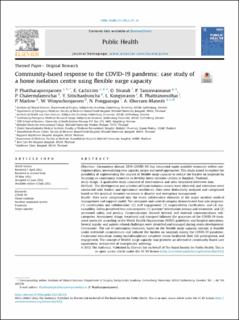| dc.identifier.citation | Phattharapornjaroen, P., Carlström, E., Sivarak, O., Tansuwannarat, P., Chalermdamrichai, P., Sittichanbuncha, Y., Kongtoranin, L., Phattranonuthai, R., Marlow, P., Winyuchonjaroen, W., Pongpasupa, N. & Khorram-Manesh, A. (2022). Community-based response to the COVID-19 pandemic: case study of a home isolation centre using flexible surge capacity. Public Health, 211, 29-36. | en_US |
| dc.description.abstract | Objectives: Coronavirus disease 2019 (COVID-19) has consumed many available resources within contingency plans, necessitating new capacity surges and novel approaches. This study aimed to explore the possibility of implementing the concept of flexible surge capacity to reduce the burden on hospitals by focussing on community resources to develop home isolation centres in Bangkok, Thailand.
Study design: A qualitative study consisted of observational and semi-structured interview data.
Methods: The development and activities of home isolation centres were observed, and interviews were conducted with leaders and operational workforces. Data were deductively analysed and categorised based on the practical elements necessary in disaster and emergency management.
Results: Data were categorised into the seven collaborative elements of the major incident medical management and support model. The command-and-control category demonstrated four subcategories: (1) coordination and collaboration; (2) staff engagement; (3) responsibility clarification; and (4) sustainability. Safety presented two subcategories: (1) patients' information privacy and treatment; and (2) personnel safety and privacy. Communication showed internal and external communications subcategories. Assessment, triage, treatment and transport followed the processes of the COVID-19 treatment protocols according to the World Health Organisation (WHO) guidelines and hospital operations. Several supply- and patient-related challenges were identified and managed during centre development.
Conclusions: The use of community resources, based on the flexible surge capacity concept, is feasible under restricted circumstances and reduced the burden on hospitals during the COVID-19 pandemic. Continuous education among multidisciplinary volunteer teams facilitated their full participation and engagement. The concept of flexible surge capacity may promote an alternative community-based care opportunity, irrespective of emergencies' aetiology. | en_US |

